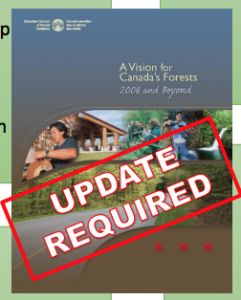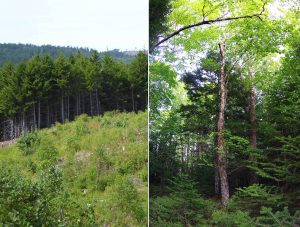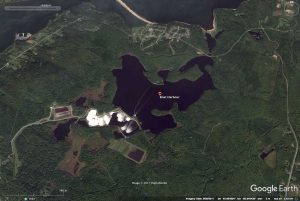And some thoughts on the impacts on wood markets if Nova Scotian woodlot owners could benefit from carbon markets
Addendum May 3, 2018: Listening to Dale Prest on CBC this morning, I realized I had not done my homework properly. Apologies to readers. It is not just the high volume stands that can benefit from carbon offset credits (as implied in the post originally – that has been corrected) but the high volume stands would be the most valuable. Any management program that would increase the carbon stored on a property would in principle be eligible for carbon offset credits; as more carbon is stored the $ return increases, so the higher the volume initially, the higher the return initially*. A 100 year commitment is required. There is a lot more involved. Currently there is no system in place in Nova Scotia to facilitate woodlot owners participating in carbon markets. Dale Prest is heading up the recently formed Climate Forest Company which will assist Maritime woodlot owners seeking to participate in carbon markets. Some further notes and links on forest carbon offsets are appended at the end of this post.
_________________
*I checked with Dale Prest on the accuracy of this statement (“as more carbon is stored the $ return increases, so the higher the volume initially, the higher the return initially”). He says it “is indeed accurate, as those with more carbon will be able to sell more carbon credits and realize higher returns both initially and throughout the life of the project.” He also commented:”No one has figured out how to structure payments for small family woodlot owners. Money is trading hands using the Forest Carbon Works system so obviously they have a lot figured out, however no harvesting is allowed in those forests, an important caveat to some. [Last sentence edited May 4, 2018]. The only projects that have been developed are on large land bases owned by single individuals, which is considerably more straight forward.” The Climate Forest Company is developing/promoting a system that would allow smaller woodlot owners in the Maritimes to participate in carbon markets.
————————

Merchantable forest volumes in sections of eastern NS (above) and southwest NS (below) After centuries of intensive harvesting, high volume forests stands now exist only as a patchwork throughout the province. The darker patches in the maps above have the higher volumes that store the most carbon and that would be most valuable to woodlot owners participating in carbon markets under an expanded Cap and Trade system for Nova Scotia. High volume stands are most abundant in SW Nova Scotia, now the focus (or desired focus) of industrial forest harvesting in Nova Scotia.
Click on image for larger version
Begin post of May 1, 2018: Nova Scotia introduced its Cap and Trade Legislation on Sep 29, 2017; it was given Royal Assent on Oct 26, 2017. The system is restricted to the province of Nova Scotia and has no provisions that would enable private woodlot owners to benefit from carbon offsets* as promoted by Dale Prest:
“Prest says the province needs to implement the right cap-and-trade system, one that openly trades with markets in Ontario, Quebec and California. But the province has initially committed to creating their own system, with all the trading done within Nova Scotia, although they’re open to options.”
Prest believes that major financial benefits for woodlot owners and rural communities could be realized and that opening the market up would prompt a move “From one [a forest industry] that rewards a low cost of production that results in clear cutting, to one that rewards maintaining and growing a healthy forest as possible.” – in Cap-and-trade system could help province’s forestry industry by Amanda Panacci for Chronicle Herald Nov 23, 2017
Continue reading →
 This message from Julie Towers, Deputy Minister, NSNDR has been circulating:
This message from Julie Towers, Deputy Minister, NSNDR has been circulating:





